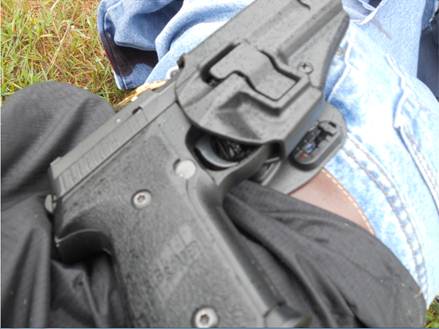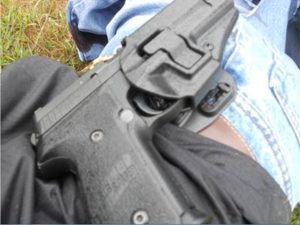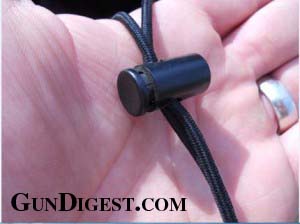

When you are buying a CCW holster and a cover garment look for the little things that can hang up and possibly cause an unsafe situation. You will be glad you did.
The two key elements of concealed carry are, of course, “concealed” and “carry”. To effectively carry you need a holster. To effectively conceal you need cover garment. When those two get tangled up you can get holes in your body where holes should not be. Nobody wants that. Here is an abridged version of a report sent out to alert Law Enforcement Officers of a potential for disaster posed by the most innocuous of items… the draw cord on your pull-over cover garment. I am taking pains to insure all references to where and to whom this happened are removed.
In June 2012, a group of LEOs was participating in firearms training at the range with the department’s issued pistol and ammunition. The officer was using a .40 S&W caliber SIG P229 DAK. The ammunition was department-issued Federal Premium 180-grain HST. The holster utilized was a right-handed Blackhawk Serpa CQC concealment paddle-style. The officer was wearing a light-weight wet weather jacket due to rainy conditions on that day.
After having fired several rounds during the course of fire, the officer was in the process of holstering when the pistol discharged through the open portion of the bottom of the holster. The round entered the outside of the right upper calf and exited the outside of the lower calf and was stopped by the ground (grass/dirt surface). The round did not strike any bone or the ankle or foot. There was not excessive bleeding and it was later found that there was no serious nerve damage. The officer is expected to make a full recovery.
Once first aid was rendered and EMT’s had arrived at the scene, an examination of the pistol in the holster revealed that the trigger was depressed to the rear of the trigger guard (see photograph). A plastic cylinder-shaped draw cord adjuster attached to the wet weather jacket the officer was wearing was lodged against the front of the trigger. The plastic draw cord adjuster had become caught inside of the trigger guard during the holstering of the pistol.

It should be noted that this type of draw cord adjuster is the type commonly found on many jackets. The one that became lodged was for the side/waist adjustment cord.
Just a reminder to trainers and shooters. We train to keep our eyes up on threat when holstering. When holstering with this type of clothing and using the support hand to clear the holster, ensure that the support hand doesn’t get covered by the muzzle. Keep the support hand and clothing well above the top of the holster and bring the pistol in below them.
This situation could have ended much worse. I was at a range where a shooter did much the same thing while trying to holster his Glock with his finger inside the trigger guard. Massad Ayoob tells a story of shooter getting off two rounds in such fashion because he didn't realize the “cause and effect” and once the first round went off he really wanted to get that pistol safely into the holster, so he pushed down again!
This is no laughing matter. Learn to holster carefully. As cops, we holster with our eyes on the threat in order to transition to

handcuffing or some other activity. You civilian CCW holders should not holster until you are certain the scene is safe. That usually means when police arrive. At that point you may be directed (loudly) to place your gun on the ground while police sort out the situation. Do so without hesitation because responding officers don't know who is the bad guy when they arrive at a “shots fired” call.
So, when you are buying a holster and a cover garment look for the little things that can hang up and possibly cause an unsafe situation. You will be glad you did.

Next Step: Get your FREE Printable Target Pack
Enhance your shooting precision with our 62 MOA Targets, perfect for rifles and handguns. Crafted in collaboration with Storm Tactical for accuracy and versatility.
Subscribe to the Gun Digest email newsletter and get your downloadable target pack sent straight to your inbox. Stay updated with the latest firearms info in the industry.

![Best Concealed Carry Guns In 2025 [Field Tested] Wilson Combat EDC X9S 1](https://gundigest.com/wp-content/uploads/Wilson-Combat-EDC-X9S-1-324x160.jpg)


![Best 9mm Carbine: Affordable PCCs [Tested] Ruger Carbine Shooting](https://gundigest.com/wp-content/uploads/Ruger-Carbine-Shooting-100x70.jpg)
![Best AR-15: Top Options Available Today [Field Tested] Harrington and Richardson PSA XM177E2 feature](https://gundigest.com/wp-content/uploads/Harrington-and-Richardson-PSA-XM177E2-feature-100x70.jpg)

Hey Kevin,
Ive been looking long and hard for a good holster for my XD.
After a month of looking, I finally found one. I’ts kydex, comes in a great amount of colors, has GREAT retention, and fits AWESOME. The company name and website it http://www.multiholsters.com
You want to do a great article for your fellow gun followers, this holster will not disappoint.
Just wanted to pass this info around.
Thanks ghost rider
I normally don’t respond to these things, but as a firearms instructor with a Federal Agency I can tell you that this LEO was following procedure. His pistol, a SIG P229 with the DAK trigger is a DAO, no safety, bobbed hammer, and a fairly light DA trigger pull, once the slide has been retracted as would be the case when a round is chambered or the pistol fired. We normally run a “Hot Range” so he reholstered with a round in the chamber, which would also mean that DAK trigger mechanism was activated. The problem as I see it is a combination of holster design and just plain bad luck. The LEO was holstering while assessing his threat area as he has been taught. The open top design of that Blackhawk SERPA holster allowed the draw cord adjuster from his jacket to fall down inside the holster. The combination of the DAK trigger, holster design, jacket type and “Mr. Murphy” caused a true AD – accidental discharge. My agency has similar jackets, but our duty and off-duty holsters have a safety strap or thumb-break that make it more difficult for this type of accident to happen. I’m glad this LEO wasn’t more seriously injured, but in no way was he negligent. If anything maybe his agency needs to reconsider their approved holster list. Murphy is alive and well and sometimes no matter what you do something bad is going to happen.
The lesson to take from this example is to clear your holster before putting the gun back in place. There is no need to re-holster until the danger is cleared, and once the situation is safe, look at the holster, move your jacket out of the way, and slowly, carefully, re-holster. This will work for 1911s, Glocks , and any other gun out there. Safe Shootin’
Why would an LE “professional” or anyone else holster a weapon in condition 1 ???
Another words, magazine loaded, round in the chamber, safety off and weapon ready to fire. An 18 year old just out of basic training knows better than this.
I would expect that once the investigation is completed, the officer will be determined to be negligent and “unsafe”, meaning he will require additional training….and rightly so.
Yes this is a sad event, and accidents do happen, but this is more than an accident. This is incompetence. Fortunately the wound was not more serious or an innocent bystander was not shot or possibly killed in the event of a ricochet.
Retired 75th, (am I to assume Ranger Regiment?) with all due respect, nearly all law enforcement officers carry in Condition 1. This is because most modern, pistols used for LE work do not have an external safety. Striker fired pistols like the Glock, Springfield XD, etc rely on internal safety mechanism. The Beretta 92G uses a decocker that returns to the fire position once depressed. In this case the pistol was a SIG with a DAK trigger system, which delivers a safe, reliable and consistent 6.5 pound double-action only trigger pull on the Sig 229. It is supposed to be like shooting a revolver, simple with nothing else to engage or disengage under stress. This officer was not negligent, he was not trained. This is a training issue and this post what made to highlight the fact that some elements of training are being overlooked. There may be a bigger debate buried here that sometimes agencies, in an effort to save money, substitute gear for training, because training costs more. But in this case, the officer was doing as he was trained. The goal is here is to get people to review their training protocols and think about any little thing that can go wrong.
I agree, WHY was he holstering his weapon with safety OFF !
There appears to be a disconnect here between what people think they know about pistols and the actual features on certain pistols. Not all pistols have manual external safety levers. This pistol did not have one. The safety mechanism is all internal. If this had happened with a revolver would anyone have asked why the officer tried to holster with the safety off? Massad Ayoob trains shooters to keep their thumb on the hammer during holstering. That may have helped here. But the real issue is to watch out for anything that may catch on the trigger and to holster slowly and with care. By the time you are ready to holster the gun you should believe the fight is over (this may or may not be true) but there is no hurry to put your gun away. Another threat may appear. Holster slowly.
Too many of the semi autos are tempting fate even with those that are well trained with the individual weapon. I recently bought a glock 36, fired a few rounds and sold it. Not a handgun that I would hand to one of my grandsons. One reason the marines have went back to the 1911 is it is a safe handgun that you have to work very hard to make fire accidently.
Definitely a timely head’s up. And that holster doesn’t breed much confidence, either.
I would not blame the holster too much. Any good stiff holster would have pushed that drawcord lock against the trigger. But think about this… if he had been shooting a 1911 and, as trained, engaged the frame-mounted safety before holstering, this accident would not have happened.
I don’t happen to think the 1911 is the best design in the world, but I do love the fact that is has a frame-mounted safety AND a grip safety.
I agree, Kevin, that the drawcord lock was probably going to cause an ND no matter what (except for the case of an external safety, of course).
What I was referring to was the release tab on those Blackhawk holsters. You press it with your trigger finger, then draw the weapon. If you do it right, your finger slides into position alongside the slide, right where it should be. But it’s easy to push with the tip of your finger, which tends to cause your trigger finger to pop into the triggerguard and puts it right on the trigger, right when you don’t want it to be there.
I switched to a Safariland holster, which has a thumb-operated release. I just felt that the Blackhawk release was tempting fate. And I also carry a 1911 – I’m a fan of the multiple safeties, too.
This gun has an external hammer, right?
Following Ayoob’s safety video advice (not to mention all I learned from my father about hunting), I don’t depend on my M1911’s very nice external safety, I put my thumb in front of the hammer when holstering. If, somehow, everything else fails, it should catch the hammer before it can fire a round.
For guns like this, you’re supposed to put your thumb on top of the hammer and if you feel lifting up, STOP!
That’s why I won’t carry a striker fired handgun, which has no external hammer of either sort.